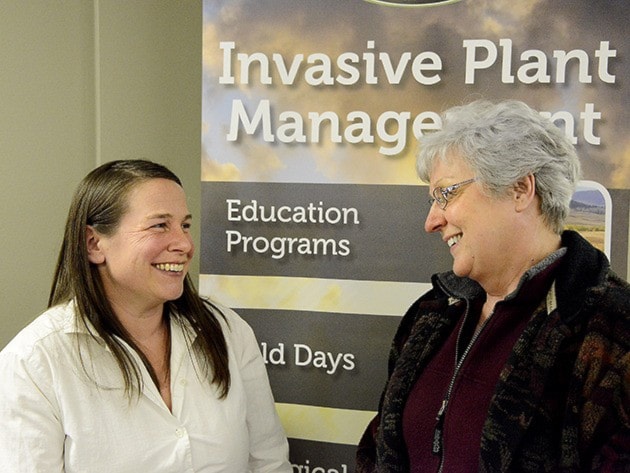“It sounds like something from a horror movie.”
That was the reaction from Jamie Vieira, manager of environmental services with the Thompson-Nicola Regional District, after hearing a presentation by Dr. Catherine Tarasoff on the dangers of Japanese knotweed.
Tarasoff gave her presentation to Clearwater town council during its March 7 meeting.
She plus other representatives from the TNRD and Invasive Species Council of BC also gave presentations to a public meeting that evening at Dutch Lake Community Centre.
Japanese knotweed has been a persistent pest in the Lower Mainland for many years, Tarasoff said.
Recently a small patch of it was found near Dutch Lake in Clearwater.
The plant has jointed stems, similar to bamboo, but has wide leaves.
Its roots can go down three meters and reach more than 14 meters – enough to cross a four-lane highway.
The plant can flourish in a wide range of ecosystems. It reduces biodiversity, can cause flooding by clogging waterways, increases erosion, and its litter can increase fire risk.
It can get into houses and crack foundations. In the United Kingdom, it has resulted in decreased property values so much that people are unable to get mortgages.
The patch in Clearwater was discovered when its roots got into a septic system.
Those fixing the septic system thought a first the roots came from a nearby tree, which was then cut down – causing the knotweed to grow even faster.
This was significant because the only way to control the plant is through repeated and generous treatments with herbicides such as glyphosate (Roundup), and the patch is only a short distance from the lake.
Chemical treatment must be done at least twice a year, in April or May and before the first frost.
Physically cutting the plant might eliminate it – if the patch is small enough and if it is done twice a month for at least five years.
Compost facilities elsewhere require that plant parts from Japanese knotweed be buried at least five meters deep and at least 20 m from the nearest edge.
The biggest source of transmission is illegal dumping of plant parts, Tarasoff said. A piece less than one gram in weight can reproduce.
The roots can remain dormant for 10 years, she said.
Assistance for landowners
The TNRD’s weed control program was originally set up to deal with knapweed, environmental services manager Jamie Vieira told town council.
It has achieved some success, especially since adding bio-control treatments.
Equipment for chemical treatments is available for loan out to landowners.
Rebates to landowners cover 50 per cent of the cost of treatment unless the infestation is by a designated “new invader,” in which case the rebate covers 100 per cent of the cost.
About 18 months ago the TNRD board adopted a noxious weed bylaw, which can require landowners to treat infestations.
This is only used on a case-by-case basis, Vieira said.
The weed control program costs about $300,000 per year and covers the TNRD’s electoral areas only. Municipalities such as Clearwater need to develop their own program, although Vieira said possibly they could work together with the regional district.
Invasive Species Council here to help
Dave Ralph, project manager with Invasive Species Council of BC, gave a presentation to town council as well.
The council was started in about 2005 to deal with invasive plants and then was expanded in 2010 to 2012 to include all invasive species.
Purpose of the council is to minimize the environmental, social and economic impacts of invasive species, he said.
Much of the work is done through 14 independent regional committees.
One important program is “Clean, Drain and Dry,” which encourages boaters to take steps to control the spread of zebra mussels and similar possible problem species.
The “Plantwise” and “Grow Me Instead” programs work with the horticulture industry and gardeners to help control invasive plants.
About 70 per cent of invasive plants are introduced intentionally, he said.
